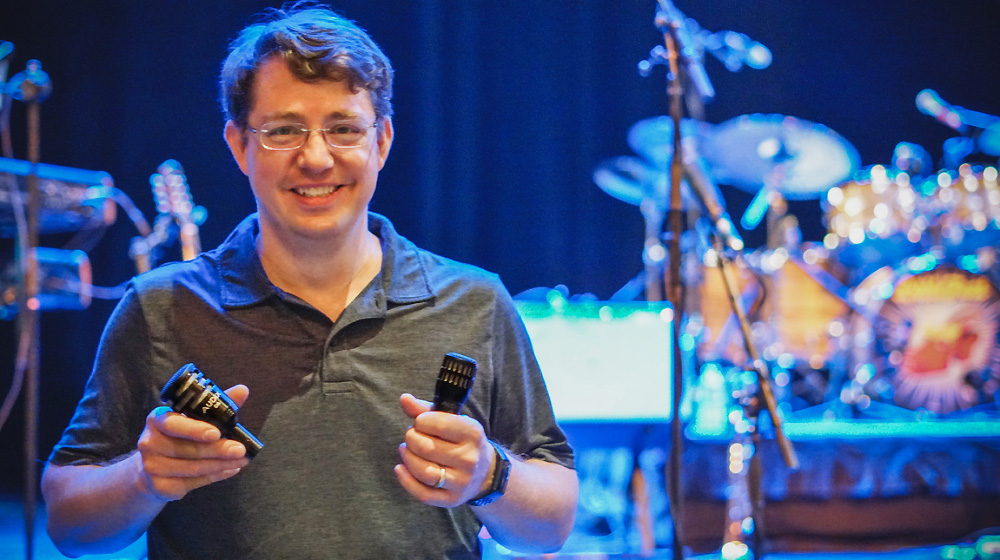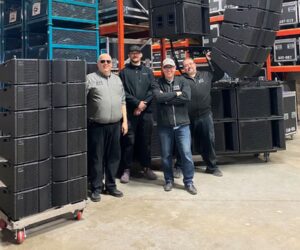Veteran recording and concert engineer Charles A. Martinez, who spent a decade as chief engineer at NYC’s Dangerous Music studios working with artists such as Mick Jagger and Keith Richards, has recorded Broadway cast albums, engineered two songs on Toots and the Maytals’ True Love that won a Grammy Award for Best Reggae Album in 2004, mixed FOH for Steely Dan for several years — and even restored forensic audio for the FBI — is set to tour with Foghat and Little Feat utilizing a range of Audix microphones.
Martinez also stands poised to record dates in full multitrack, entrusting post-show mixing to his set of Audix A150 headphones. Among the mics he will deploy are a D6 for kick drum, i5 and D4 instrument mics on snare and toms, respectively, and SCX25A condensers on anything he chooses.
“My family was musical,” he recalls. “We always had a piano in the house and sing-alongs, and I have recordings of me singing with my dad at the piano from as young as two and a half. I started piano lessons at six, violin at nine, bass at 12. Oddly, I got a bass performance scholarship to St. John’s University — where I studied to be a pharmacist. I guess the idea was to make good money so I could buy music gear.
“Halfway through, I decided I liked recording more than learning how to accept insurance and count pills. I did the engineering program at the Institute of Audio Research in Manhattan and right after graduating, started at Dangerous Music recording studios. The Rolling Stones did a ton of stuff for Bridges to Babylon there.”
It’s commonly taught in professional recording that mixing primarily or even exclusively on headphones is not done, but Martinez disagrees. “I’ve always been a huge fan of Audix mics, but I wasn’t in the market for headphones when the A150s first came out,” he explains. “I didn’t want to be the guy returning them with lukewarm feedback. But then put I them on. I didn’t have to learn them. Older mixes I’d done on near- or mid-field monitors, or on some of my other headphones, translated perfectly in the A150s.
“When I mixed new stuff, then put it up on my main studio monitors, in my car, wherever, everything just translated beautifully. They were very accurate. I could hear all the nuance. The low end didn’t get lumpy or thin, and the stereo imaging maintained my intent. Plus, they’re comfortable to wear and not fatiguing to listen to for extended periods.
“Bottom line, they simply sound better than my other headphones. I’ve already mixed an album on them — Rustbelt by Scott Sharrard, who was Gregg Allman’s musical director then joined Little Feat in 2020. I also tried the A152s, which have this luxurious, tight bass extension, but opted for the 150s for my work. They’re both winners in my opinion.”
While the D6 has earned a position as a go-to bass drum mic, Martinez highlights its fidelity on other sources. “I was running low on mics for a horn section at one gig, so I thought I’d try it on baritone sax,” he recalls. “I fell in love with it immediately. I keep a low profile on social media, and I think that was one of the only things I posted on Twitter that entire year! The D6 has since become a requested mic for bari sax. Just recently I used a D6 on the bottom rotor of a Leslie speaker as well. It was perfect because you could roll off a lot of the highs but still keep great definition.”
He adds that the i5 “has all of the meat but none of the rumble. It has that crispness on the top end but is never harsh. If you think of mics as EQ devices, the i5 is like the EQ curve I’d apply after the fact, only before the fact.”
His most recent discovery is the SCX25A studio condenser: “A couple of years ago Audix let me borrow a bunch of mics I hadn’t heard before. I was a holdout on the SCX25As but didn’t realize how much I relied on them until I was asked to give them back. I use them on toms, as overheads, on vocals, as room mics, on acoustic instruments like string sections. With the piano clips, a pair provides the best closed-lid piano sound you can get, and I’ve tried literally everything. The SCX25As just have a richer, more natural tone. They’re euphonic and not hyped. I don’t want to talk down about anyone else’s product, but I consider them a more hi-fi 414. They just sound great on more sources without needing to EQ afterwards. They’re also surprisingly shock-resistant.”
Often microphones offer a choice between high SPL handling and detail. Martinez describes how Audix offers both across all the models he uses, and how that’s a must for his client roster. “Take Foghat. It’s hard-hitting boogie rock, and fans want to be smacked in the face with that energy when they see a show,” he explains. “Whereas Steely Dan has more engineers, musicians, and producers in the audience than probably any other band. That audience wants a hi-fi living room experience. Little Feat is somewhere in between, with players covering multiple instruments and all singing. What I see Audix equipment as doing is letting me cater to each of those very different audiences without worrying about it.”




















